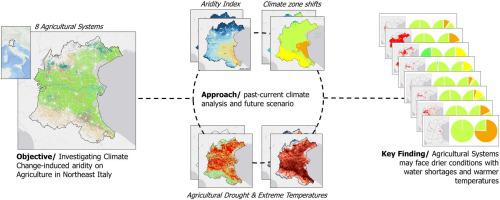Agricultural Systems ( IF 6.1 ) Pub Date : 2023-04-05 , DOI: 10.1016/j.agsy.2023.103647 Eugenio Straffelini , Paolo Tarolli

|
CONTEXT
The Mediterranean basin and specifically Northeast Italy are recognised as climate change hotspots. The latter is a key socio-economic area in Europe among the most agriculturally productive. However, increasingly frequent drought periods (typical of drier climates) are threatening agriculture. An extreme event occurred in the summer of 2022. It dramatically affected northern Italy, through high temperatures, water shortages and indirect processes (such as saltwater intrusion in the Po River Delta).
OBJECTIVE
The objective is to map and quantify the agricultural areas in Northeast Italy at risk of climate zone shift due to human-induced climate change, providing a comprehensive overview of the main threatened agricultural systems and supporting the use of projections through historical data analysis.
METHODS
We compared the distribution of current (1980 > 2016) and future (2071 > 2100; RCP8.5 scenario) climate zones for 8 main agricultural systems in 14 key provinces in Northeast Italy. Further analyses were performed on historical data to support future climate projections and to analyse agricultural drought during extreme events: (1) a multi-temporal Aridity Index (AI) to investigate aridification dynamics; (2) a focus on the 2022 event (drought and temperature extremes, a situation that is likely to occur more often in the future), combining a Vegetation Health Index (VHI) with a zonal investigation of high Land Surface Temperature (LST); (3) a climate focus for the Po River Delta cultural landscape.
RESULTS AND CONCLUSIONS
The results show that the climate in Northeast Italy is evolving towards drier conditions, posing a challenge to agriculture. The Adriatic coast could become an Arid zone, a finding in line with historical observations. Rice fields will be most at risk (76% of their surface could become Arid in the future), as well as the irrigated lands that are essential for food security (around 20% expected in the Arid zone). Worthy is what is foreseen for crops on slopes (often not irrigated), which may experience drier summers (60% of the surface).
SIGNIFICANCE
We identified the areas at risk of climate change at the farm scale in Northeast Italy, mapping where the threatened fields are located, what their extent is, and which agricultural systems are currently implemented. Such information would facilitate early action, guiding large-scale planning towards more resilient agriculture. Findings could promote sustainable water management plans, open the debate on which crops are worth growing based on future climate, and inspire more localised studies in the design of mitigation measures.
中文翻译:

气候变化引起的干旱正在影响意大利东北部的农业
语境
地中海盆地,特别是意大利东北部被公认为气候变化热点。后者是欧洲农业生产率最高的关键社会经济区。然而,越来越频繁的干旱期(典型的干旱气候)正在威胁着农业。2022 年夏季发生了一次极端事件。它通过高温、缺水和间接过程(例如波河三角洲的盐水入侵)极大地影响了意大利北部。
客观的
目标是绘制和量化意大利东北部因人为气候变化而面临气候带变化风险的农业区,全面概述主要受威胁的农业系统,并通过历史数据分析支持预测的使用。
方法
我们比较了意大利东北部 14 个重点省份 8 个主要农业系统当前(1980 > 2016)和未来(2071 > 2100;RCP8.5 情景)气候带的分布。对历史数据进行了进一步分析,以支持未来的气候预测并分析极端事件期间的农业干旱:(1)多时相干旱指数(AI)研究干旱动态;(2) 关注 2022 年事件(干旱和极端温度,未来可能更频繁发生的情况),将植被健康指数(VHI)与高地表温度(LST)的分区调查相结合;(3) 以气候为重点的波江三角洲文化景观。
结果和结论
结果表明,意大利东北部的气候正朝着干燥的方向发展,对农业构成挑战。亚得里亚海沿岸可能成为干旱地带,这一发现符合历史观察。稻田面临的风险最大(未来 76% 的地表可能会变得干旱),以及对粮食安全至关重要的灌溉土地(预计约 20% 位于干旱地区)。值得一提的是,斜坡上的作物(通常没有灌溉)可能会经历干燥的夏季(60% 的地表)。
意义
我们确定了意大利东北部农场规模的气候变化风险区域,绘制了受威胁田地的位置、范围以及目前实施的农业系统。此类信息将有助于及早采取行动,指导大规模规划以实现更具弹性的农业。研究结果可以促进可持续的水资源管理计划,开启关于根据未来气候种植哪些作物的辩论,并激发在缓解措施设计方面进行更多本地化研究。











































 京公网安备 11010802027423号
京公网安备 11010802027423号